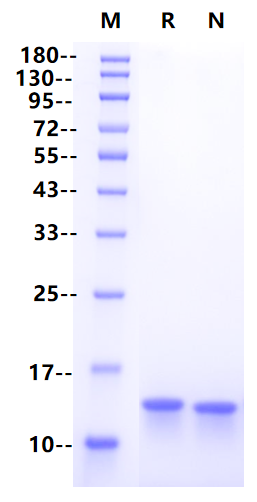IQRTPKIQVYSRHPAENGKSNFLNCYVSGFHPSDIEVDLLKNGERIEKVEHSDLSFSKDWSFYLLYYTEFTPTEKDEYACRVNHVTLSQPKIVKWDRDMHHHHHH
12.6 kDa(Reducing)
Reconstitute at less than 1 mg/mL according to the size in ultrapure water after rapid centrifugation .
· 12 months from date of receipt, lyophilized powder stored at -20 to -80℃.
· 3 months, -20 to -80℃ under sterile conditions after reconstitution.
· 1 week, 2 to 8℃ under sterile conditions after reconstitution.
· Please avoid repeated freeze-thaw cycles.
The major histocompatibility complex (MHC) gene locus encodes a group of highly polymorphic, cell surface proteins that play a broad role in the immune response to protein antigens. MHC molecules function by binding and presenting small antigenic protein fragments to antigen-specific receptors expressed by T cells (TCR). Class I MHC molecules consist of two separate polypeptide chains. The class I α chain is an MHC encoded, transmembrane polypeptide containing three extracellular domains: α1, α2 and α3. The second chain consists of a non-MHC encoded, 12 kD polypeptide called β2 microglobulin (β2M). Since β2M does not contain a transmembrane domain, it associates with the a chain through non-covalent interaction. This association is important for the stability of the MHC class I structure, its peptide-loading and its ability to present peptide antigen to CD8+ T cells. β2M is relatively invariant within each species. For example, human β2M is reported to have high affinity for human and mouse MHC class I heavy chains.
